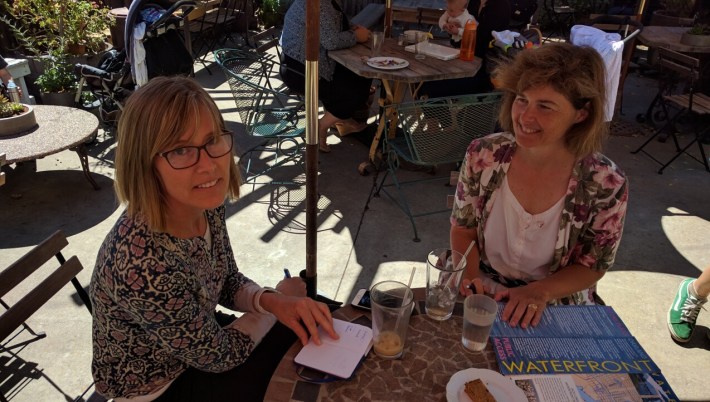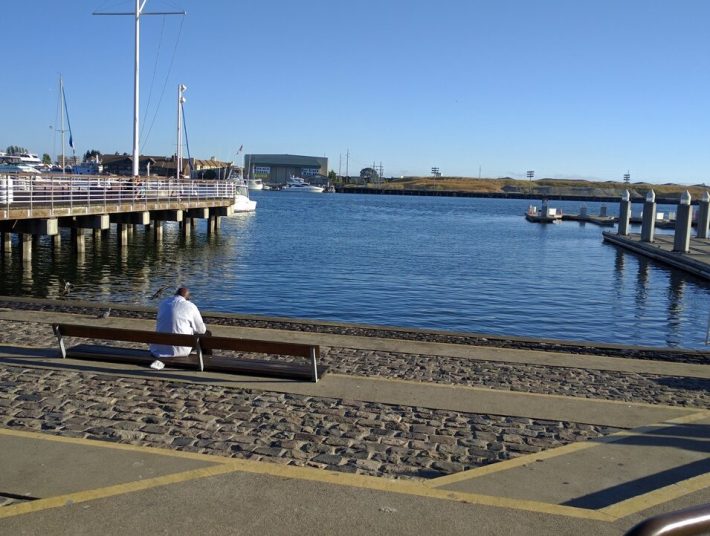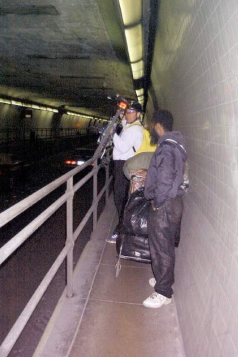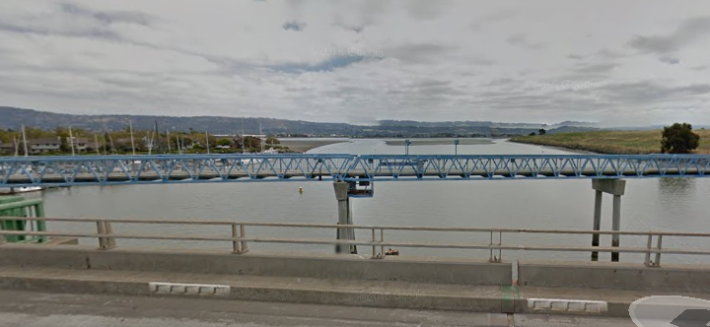
There are few places in the Bay Area where the expression "you can't get there from here" more aptly applies. Stand at the estuary at Jack London Square, and one can see the west Alameda piers clearly, just a half-mile away. But try to get there and it turns into a two-mile-plus circuitous trek that requires back tracking towards Oakland to the entrance of the tunnels. By bike or on foot, it means a miserable, loud, and uncomfortable journey through the Posey Tube, with its narrow sidewalk and railing.
"We know a bridge is the only solution that is really going to solve Alameda's west-end traffic problem," said Lucy Gigli, President of the volunteer organization BikeWalkAlameda, in a meeting with Streetsblog at Julie's Coffee & Tea Garden on Park Street, one of the organization's unofficial offices. "It's the most favorable solution that will meet the long term goals."
That's why Gigli, Cyndy Johnsen (another advocate and volunteer with the group), and BikeEastBay are pushing for a bike and pedestrian bridge across the estuary--one similar to the Bay Farm Island Bicycle Bridge, which spans the San Leandro Bay inlet to the Oakland Estuary. That bridge, which was completed in 1995, is roughly 860 feet long and cost $3.5 million. It is also the only bike-and-pedestrian drawbridge in the U.S. The bridge to Jack London would be longer, of course, and, according to an initial study, would cost roughly $60 million. "People say it's too expensive, but people don't really know; some say if it's just for bikes and peds, who's going to use it?" said Johnsen.
But the arguments for building the bridge are clearly delineated in BikeWalkAlameda's material:
- The Posey Tube/Oakland Connection is identified as the number one priority in the City of Alameda Bicycle Master Plan.
- Pedestrians and bicyclists are limited to the Posey Tube walkway, which is so narrow that it cannot accommodate wheelchairs, bike trailers, or two passing bikes even with the increased width created in 2016.
- Tube capacity is limited and congestion is growing.
- A ride or walk through the Tube exposes one to sooty walls and smelly, toxic fumes.
- For this short crossing, bus access is limited and costly ($2.10); the bus capacity for bicyclists is limited to only two or three bikes per bus.
- During peak hours, bike racks are often full, which makes the service unreliable for bicyclists.
- The bus and shuttles do not provide alternatives to the tubes and are subject to traffic delays.
- The Estuary Crossing and Target shuttles have limited hours and 30-minute headways.

The idea of a bridge is not new (although the campaign by BikeWalkAlameda to get it built was restarted in May of this year). "In 2008 and 2006, when Alameda Landing started developing, we were talking about the estuary crossing; the first step was getting a feasibility study and the city got that at our insistence," explained Gigli. "About 30 options were looked at in that [initial] feasibility study."
That 136-page study was completed in 2009. It concluded that "as the populations of west Alameda and Oakland grow, congestion and conditions in the Webster Street and Posey Tubes will degrade. A new crossing for bicyclists, pedestrians, and perhaps for transit will help provide a convenient and efficient option for recreational riders, tourists, and commuters."
In that large study, a bridge was just one in a list of possibilities that included water taxis and modifications to the Posey Street tubes. But, explained Gigli and Johnsen, the long-term and most productive option was the idea of a pedestrian and bike drawbridge. Of course, some are already asking for automobile lanes on the bridge. But "that's not even in the possibilities. It constantly comes up, but cars will add to the costs tremendously, and there's also the issue of ramps," to get to the bridge, said Gigli. They're asking the Cities of Alameda and Oakland to support a feasibility study for a bicycle and pedestrian bridge in the Alameda Countywide Transportation Plan for the next round of funding.

Getting a bridge built for bikes and pedestrians only may be challenging, but BikeWalkAlameda has already chalked up some significant victories in the fight to make streets safe for all users. About a year and a half ago, Alameda opened a parking-protected bike route on Shoreline Drive, in addition to stretches of protected bike lane on Fernside Boulevard and a few other spots. But it's hard to imagine a more potentially transformative project for the west end of Alameda than a bike and pedestrian bridge to Oakland, especially if safe bike routes are established from the bridge to the West Oakland and downtown Oakland BART stations, which--as the crow flies--are both less than a mile from western Alameda island. In the meantime, the nearest bridge crossing is the Park Street car bridge, but that's over three miles away.
Meanwhile, the sidewalk in the Posey Tube is currently getting a clean-up and the railing is getting pushed out a few inches to make a little more room for bikes. During the work, Alameda is providing a free, on-demand shuttle for bicyclists.
But both Johnsen and Gigli said moving the railing is just a stop-gap measure that won't solve the fundamental problem: the sidewalk is too narrow and the environment in the tunnel too oppressive and dirty to be a practical cycling route.
Interested in helping out? Visit the BikeWalkAlameda web page to get more information. And be sure to take a moment and sign their "bridge the gap" petition for a bike-ped bridge across the estuary.





